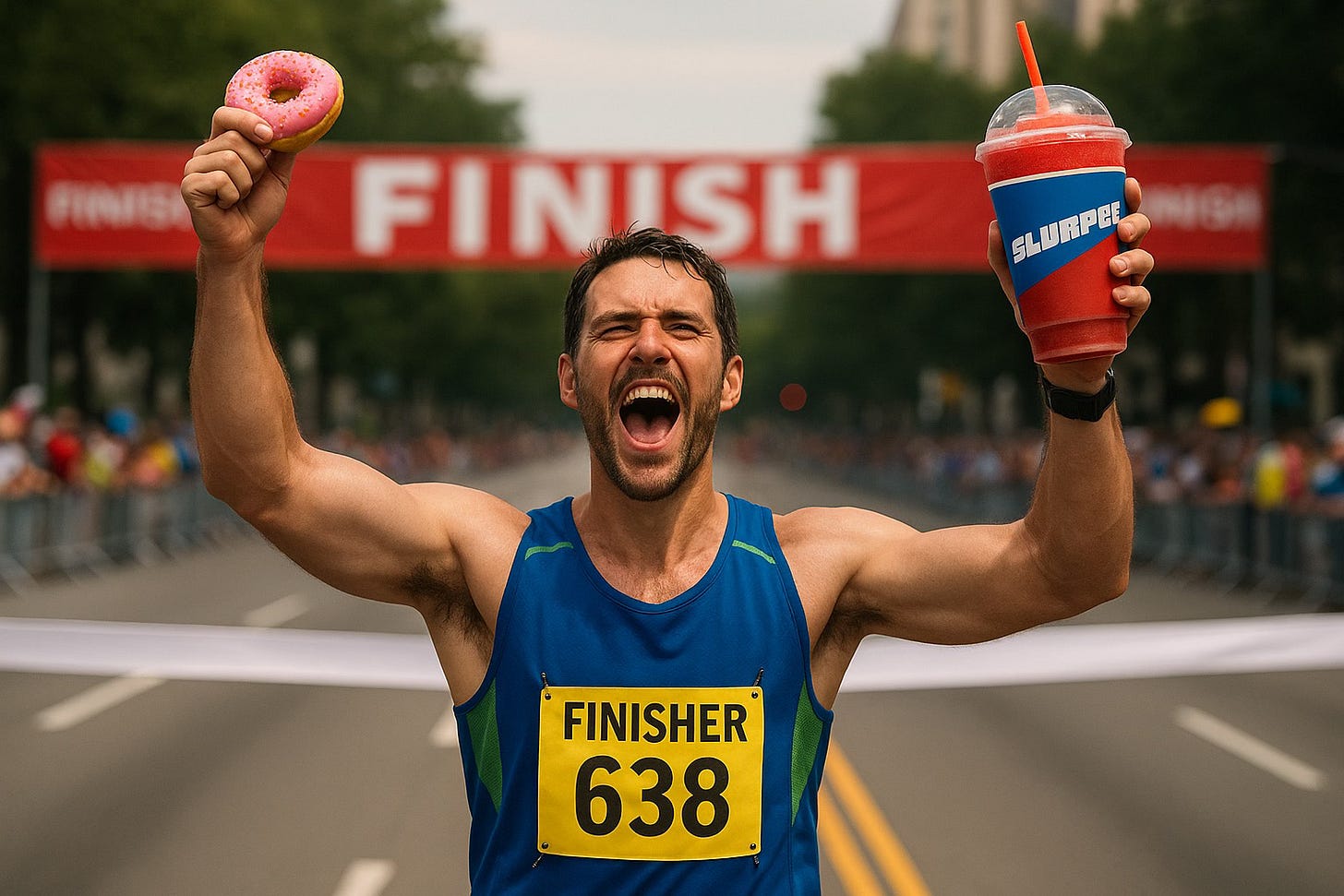You’ve just run the Great Race 5K. Good for you!
Cue the selfies. Cue the banana. Cue the medal. Cue the Eat’n Park Smiley Cookie. Cue the half bagel.
You ran 3.1 miles and burned about 310 calories.
Then you ate:
🍌 Banana: 118 calories
🍪 Smiley Cookie: 160 calories
🥯 Half Bagel: 180 calories
Total: 458 calories
That’s a net gain of 148 calories—and that’s assuming no pre-race bagel or mid-race Gatorade.
Now multiply that by 23 races. Congratulations! You’ve gained a pound.
🧠 Running Is Good for Weight Control (But Not a Free Pass)
Let’s be clear: runners tend to be leaner than the average American.
In the U.S., 71.6% of adults are classified as overweight or obese.
Among distance runners, that number drops to about 25% (Nelson et al., 2022).
So yes—running helps.
But performance is closely tied to body composition. A 2019 study of over 3,000 runners found a strong inverse relationship between body fat percentage and running speed—especially in longer races (Herrmann et al., 2019).
Ballpark targets for performance-minded runners:
Men: 10–15% body fat
Women: 18–22% body fat
🍩 Running Doesn’t Cancel Out Overeating
The point isn’t to ruin your runner’s high. It’s to spotlight a common error:
we overestimate calories burned and underestimate what we eat.
Most runners are a little too generous with their post-run indulgences. We think we’ve “earned it.” But unless you’re tracking honestly, running alone won't generate a meaningful calorie deficit.
Some programs account for this. Noom, for instance, only credits users with half the calories they burn through exercise. It’s a smart safeguard—but even that breaks down at longer distances.
🧮 Where the Rule Breaks Down
For short runs (5K to 10K), halving your burn makes sense.
But if you run 20 miles and burn 2,500 calories, should you only replace 1,250?
Not if you want to avoid crashing, illness, or burnout.
✅ A Smarter Guideline
For runs under 10 miles: Add back half the calories burned.
For runs over 10 miles: Add back half the calories burned for the first ten miles and then all the calories burned for any mile after that.
💡 Takeaways
Exercise is great. Running is great. Do it often.
But be conservative about “eating back” your workouts.
Think of food as fuel, not as a reward.
So yes—after the Great Race, go ahead and enjoy your Smiley Cookie.
Just remember: you may have outrun the competition…
but you didn’t outrun your appetite.
📚 References
Nelson, A. B., Chow, L. S., Stagg, D. B., Linderman, J. D., Stanford, K. I., & Kelly, A. S. (2022). Acute aerobic exercise reveals that FAHFAs distinguish the metabolomes of overweight and normal-weight runners. JCI Insight, 7(7), e158037. https://doi.org/10.1172/jci.insight.158037
Herrmann, F. R., Graf, C., Karsegard, V. L., Mareschal, J., Achamrah, N., Delsoglio, M., Schindler, M., Pichard, C., & Genton, L. (2019). Running performance in a timed city run and body composition: A cross-sectional study in more than 3000 runners. Nutrition, 61, 1–7. https://doi.org/10.1016/j.nut.2018.10.022




Some people who run tend to spend the rest of the day sitting.
https://www.runnersworld.com/health-injuries/a20800375/how-much-does-sitting-negate-your-workout-benefits/